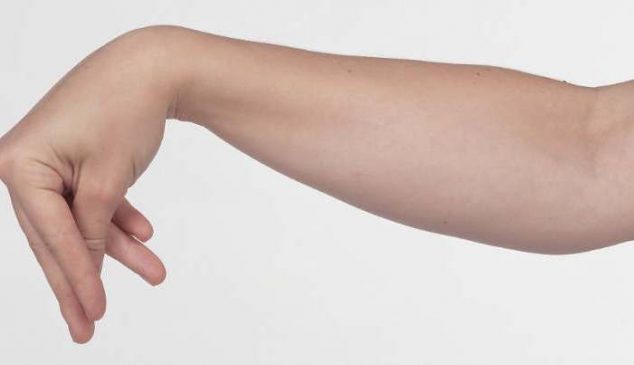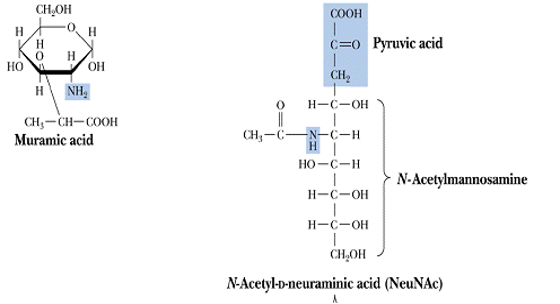Case details
A 15- year-old boy had numbness and tingling around his mouth and in his fingertips. The problem was intermittent usually occurring during times of great stress. Aside from his problem, he had been in good health. His physical examination was normal, as were his laboratory values, especially his total calcium concentration was 2.5 mM/L, with ionized calcium of 1.2 mM/L(normal 2.1 to 2.6 mM/L and 1.14- 1.30 mM/L respectively). After breathing rapidly for about 3 minutes at 30 breaths per minute, he stated that it provoked the episode. At this time he had increased irritability of his seventh cranial nerve (Chovstek’s sign) and carpal spasm on oxygen deprivation of his hand (trousseau’s sign) both indicating clinical hypocalcemia. His plasma calcium concentration during an episode remained at 2.5 mM/L but his ionized calcium level fell to 0.8 mM/L.

Picture showing-Trousseau sign
What is the cause of all these symptoms?
A) Stress-induced high catecholamine release
B) Stress-induced low PTH release
C) Respiratory alkalosis
D) Respiratory acidosis
E) Vitamin D deficiency.
The correct answer is -C) Respiratory alkalosis.
Respiratory alkalosis is a primary decrease in PCO2 with or without a compensatory decrease in HCO3 −; pH may be high or near normal.
Alveolar hyperventilation in respiratory alkalosis leads to a decreased partial pressure of carbon dioxide (PCO2). In turn, the decrease in PCO2 increases the ratio of bicarbonate concentration to PCO2 and increases the pH level. The decrease in PCO2 (hypocapnia) develops when a strong respiratory stimulus causes the lungs to remove more carbon dioxide than is produced metabolically in the tissues.
Respiratory alkalosis can be acute or chronic. In acute respiratory alkalosis, the PCO2 level is below the lower limit of normal and the serum pH is alkalemic. In chronic respiratory alkalosis, the PCO2 level is below the lower limit of normal, but the pH level is normal or near normal.
Acute respiratory alkalosis causes small changes in electrolyte balances. Minor intracellular shifts of sodium, potassium, and phosphate levels occur. A minor reduction in free calcium occurs due to an increased protein-bound fraction.
In the given clinical situation the symptoms of perioral and fingertip paresthesias etc are typical of Hypocalcaemia. When seen intermittently such as this, such symptoms are almost caused by hyperventilation.
In this patient the hyperventilation is related to anxiety.
Effect of hyperventilation on ionic calcium concentration
Normal total serum Calcium concentration ranges from 8.8 to 10.4 mg/dL (2.20 to 2.60 mmol/L). About 40% of the total blood Calcium is bound to plasma proteins, primarily albumin. The remaining 60% includes ionized Ca plus Ca complexed with phosphate (PO4) and citrate.
The circulating calcium binds to plasma proteins via anionic sites that are highly dependent on the pH of the blood. A small increase in pH creates more anionic sites for the binding of calcium.
Hyperventilation due to any cause can acutely raise the pH of the blood.
The increased respiratory rate removes carbon dioxide from the lung alveoli and lowers blood CO2, forcing a shift in the indicated equilibrium towards left.
CO2 + H2O <——–> H2CO3 <——–> H+ + HCO3–
Carbonic acid (H2CO3) can be ignored because negligible amounts are present at physiological pH, leaving the equilibrium
CO2 + H2O <——-> H+ + HCO3–
The leftward shift to replenish exhaled CO2 decreases the hydrogen ion (H+) concentration and increases the pH to produce alkalosis.
The rise in pH promotes the binding of ionic calcium to anionic sites on albumin dropping the ionized calcium by up to 30 % without altering the total plasma calcium concentration. Since it can occur in just a few seconds, PTH (parathyroid hormone) is unable to compensate for the hypocalcemia and the symptoms may occur.
PTH is secreted by the parathyroid glands. It has several actions, but perhaps the most important is to defend against hypocalcemia. Parathyroid cells sense decreases in serum Ca and, in response, release preformed PTH into the circulation. PTH increases serum Ca within minutes by increasing renal and intestinal absorption of Ca and by rapidly mobilizing Ca and PO4 from the bone (bone resorption).
Since in this case, the hyperventilation is due to anxiety the therapy should be directed at lowering the patient’s anxiety. Counseling may be necessary for this.
This respiratory alkalosis is best treated by diminishing the respiratory rate to elevate the blood [CO2], forcing the above equilibrium to the right, elevating the [H+], and decreasing the pH.
The patient can treat his symptoms by preventing the diminished CO2 that accompanies the hyperventilation. He can do this simply by breathing into paper bags, thereby increasing the CO2 of the inspired air.
As regards other options
A) Stress-induced high catecholamine release- Catecholamines have no role to play in calcium homeostasis
B) Stress-induced low PTH release- This is also not true, there is no evidence of stress-mediated PTH release.
D) Respiratory acidosis by decreasing pH promotes the ionization of calcium. Hypocalcemia is not observed in respiratory acidosis.
E) Vitamin D deficiency does not affect only ionic calcium concentration. The total calcium concentration is lowered in vitamin D deficiency.




